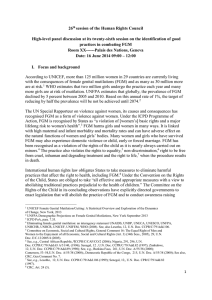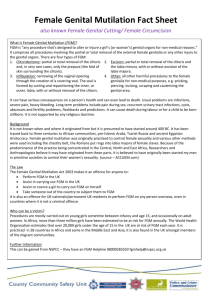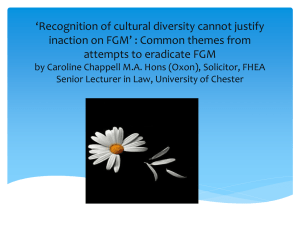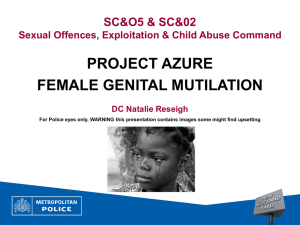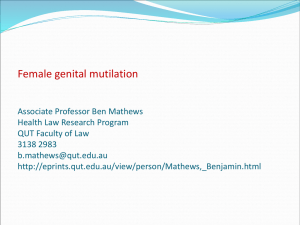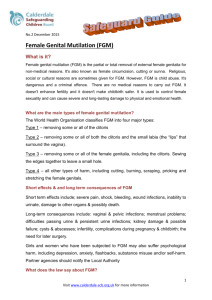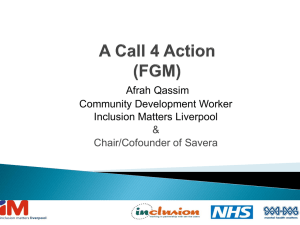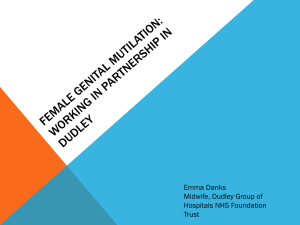French - Office of the High Commissioner on Human Rights
advertisement
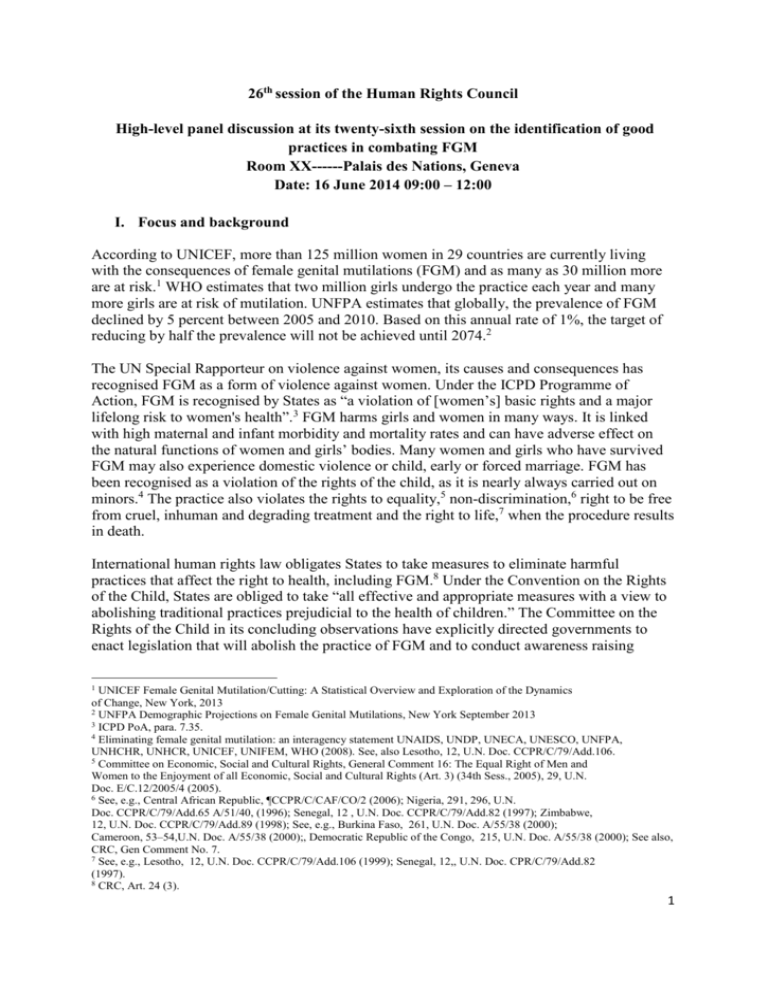
26th session of the Human Rights Council High-level panel discussion at its twenty-sixth session on the identification of good practices in combating FGM Room XX------Palais des Nations, Geneva Date: 16 June 2014 09:00 – 12:00 I. Focus and background According to UNICEF, more than 125 million women in 29 countries are currently living with the consequences of female genital mutilations (FGM) and as many as 30 million more are at risk.1 WHO estimates that two million girls undergo the practice each year and many more girls are at risk of mutilation. UNFPA estimates that globally, the prevalence of FGM declined by 5 percent between 2005 and 2010. Based on this annual rate of 1%, the target of reducing by half the prevalence will not be achieved until 2074.2 The UN Special Rapporteur on violence against women, its causes and consequences has recognised FGM as a form of violence against women. Under the ICPD Programme of Action, FGM is recognised by States as “a violation of [women’s] basic rights and a major lifelong risk to women's health”.3 FGM harms girls and women in many ways. It is linked with high maternal and infant morbidity and mortality rates and can have adverse effect on the natural functions of women and girls’ bodies. Many women and girls who have survived FGM may also experience domestic violence or child, early or forced marriage. FGM has been recognised as a violation of the rights of the child, as it is nearly always carried out on minors.4 The practice also violates the rights to equality,5 non-discrimination,6 right to be free from cruel, inhuman and degrading treatment and the right to life,7 when the procedure results in death. International human rights law obligates States to take measures to eliminate harmful practices that affect the right to health, including FGM.8 Under the Convention on the Rights of the Child, States are obliged to take “all effective and appropriate measures with a view to abolishing traditional practices prejudicial to the health of children.” The Committee on the Rights of the Child in its concluding observations have explicitly directed governments to enact legislation that will abolish the practice of FGM and to conduct awareness raising 1 UNICEF Female Genital Mutilation/Cutting: A Statistical Overview and Exploration of the Dynamics of Change, New York, 2013 2 UNFPA Demographic Projections on Female Genital Mutilations, New York September 2013 3 ICPD PoA, para. 7.35. 4 Eliminating female genital mutilation: an interagency statement UNAIDS, UNDP, UNECA, UNESCO, UNFPA, UNHCHR, UNHCR, UNICEF, UNIFEM, WHO (2008). See, also Lesotho, 12, U.N. Doc. CCPR/C/79/Add.106. 5 Committee on Economic, Social and Cultural Rights, General Comment 16: The Equal Right of Men and Women to the Enjoyment of all Economic, Social and Cultural Rights (Art. 3) (34th Sess., 2005), 29, U.N. Doc. E/C.12/2005/4 (2005). 6 See, e.g., Central African Republic, ¶CCPR/C/CAF/CO/2 (2006); Nigeria, 291, 296, U.N. Doc. CCPR/C/79/Add.65 A/51/40, (1996); Senegal, 12 , U.N. Doc. CCPR/C/79/Add.82 (1997); Zimbabwe, 12, U.N. Doc. CCPR/C/79/Add.89 (1998); See, e.g., Burkina Faso, 261, U.N. Doc. A/55/38 (2000); Cameroon, 53–54,U.N. Doc. A/55/38 (2000);, Democratic Republic of the Congo, 215, U.N. Doc. A/55/38 (2000); See also, CRC, Gen Comment No. 7. 7 See, e.g., Lesotho, 12, U.N. Doc. CCPR/C/79/Add.106 (1999); Senegal, 12,, U.N. Doc. CPR/C/79/Add.82 (1997). 8 CRC, Art. 24 (3). 1 programmes.9 In addition to enacting and enforcing specific, effective legislative measures prohibiting such practices, States are also required to ensure that active discouragement of FGM is an integral component of primary and reproductive health care programs.10 States are urged to provide girls who have suffered FGM appropriate treatment, rehabilitation and counselling.11 Regional conventions such as the Protocol to the African Charter on Human and People's Rights on the Rights of Women in Africa explicitly recognise that practices harmful to women such as FGM are violations of human rights. Globally, the majority of countries have laws and policies prohibiting the practice of FGM. In many countries with high prevalence rates, governments have, in addition to criminalising the practice, engaged in education and outreach programs, and applied civil remedies and administrative regulations to prevent the practice. Countries with migrant populations from practicing countries have also criminalised the practice either through their general criminal legislation or through specific criminal law provisions.12 In spite of progress, the practice continues to persist in many countries due to varied and complex reasons. These include, inter alia, social pressure to conform, cultural rites such as entry into adulthood and or marriage, and or notions of femininity. In some societies, recent adoption of the practice is linked to a wider religious or traditional revival movement.13 In the context of migration, it is often perceived as a way of maintaining a link to the country of origin and preserving cultural identity.14 As part of the efforts to end FGM, at its 24th session in September 2013, the Human Rights Council (HRC) adopted resolution 24/117 in which the Council decided to organise a highlevel panel discussion at its twenty-sixth session on the identification of good practices in combating FGM. This resolution follows the adoption by the UN General Assembly of Resolution 67/146 in 2012 entitled ‘Intensifying global efforts for the elimination of female genital mutilations’, its first ever resolution on the issue . II. Objectives The HRC panel will focus on progress made, good practices, and challenges and obstacles encountered in the effort to eliminate FGM. It will also address the needs of girls and women who suffer the consequences of FGM. Panellists will highlight promising practices and initiatives at the national, regional and international levels, as well as remaining challenges to address FGM and will make recommendations on the way forward. III. Composition of the Panel Opening statement: 9 See, e.g Sierra Leone CRC/C/SLE/CO/2 (2008); Nigeria, CRC/C/NGA/CO/3-4 (2010), Guinea, CRC/C/GIN/CO/2 (CRC, 2013), Egypt, CRC/C/EGY/CO/3-4 (2011) and Togo, CRC/C/TGO/CO/3-4 (2012) 10 ICPD PoA, para. 7.6. 11 ICPD PoA, para. 740. 12 In the EU, an estimated 500 000 women and girls are living with the consequence of FGM. European Parliament: Resolution on ending female genital mutilation from 16/06/2012 (2012/2684(RSP)). 13 WHO Female genital mutilation Fact sheet N°241, Updated February 2014. 14Communication from the commission to the European Parliament and the council: Towards the elimination of female genital mutilation, Brussels, 25.11.2013 COM (2013). 2 Ms. Navi Pillay, High Commissioner for Human Rights Possible Panelists: Moderator – H.E. Madam Nakpa POLO, Ambassador and Permanent Representative of Togo 1. 2. 3. 4. Hon. Mrs Chantal Compaoré, First Lady of Burkina Faso Ms Mariame Lamizana, IAC President Ms. Nafissatou Diop, Coordinator, Joint UNFPA/UNICEF Programme on FGM/C Ms. Hiranthi Wijemanne, CRC member and coordinator of the CRC Working group on the joint CRC/CEDAW general comment on Harmful practices 5. Ms. Liz Ditchburn, Policy Director, DFID 6. Ms. Marleen Temmerman, Director, Department of Reproductive Health Research IV. Format of the panel The panel will take the format of an interactive discussion. The Moderator will be responsible for setting the tone of the discussion. After the opening remarks by the High Commissioner for Human Rights, the Moderator will introduce the issue and ask panellists to respond to some questions on issues identified. The remainder of the session will be dedicated to Member States and Observers to interact with the Panellists. Representative of Member and Observer States are encouraged to share concrete examples and experiences on the issues identified in Section II above. V. Outcome OHCHR will draft a summary of the discussions. The summary will be submitted to the Human Rights Council at the 27th session. 3
